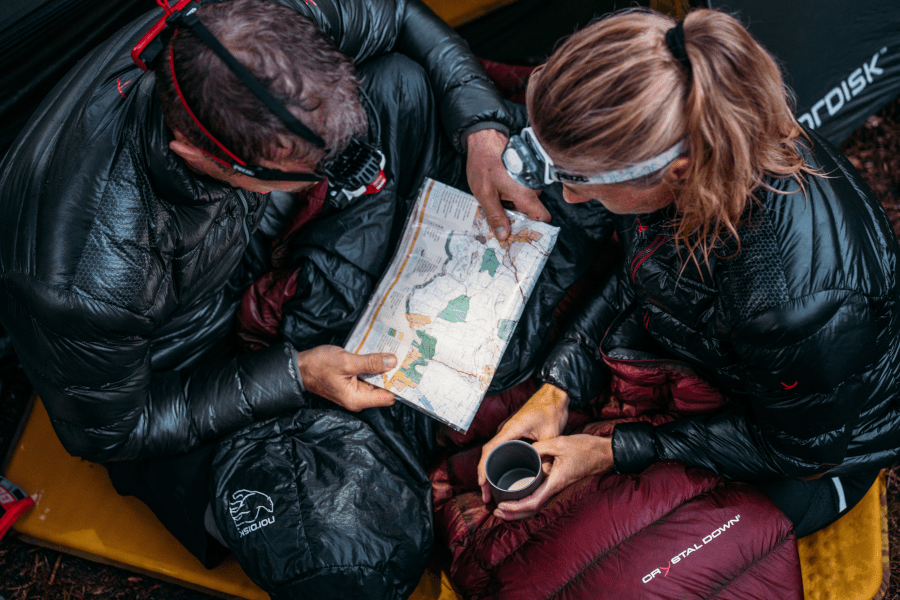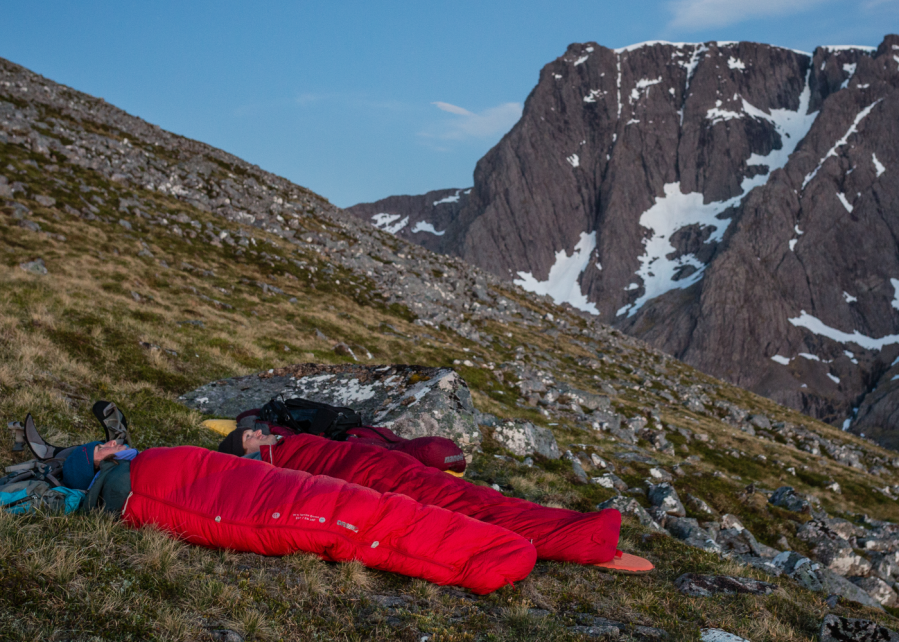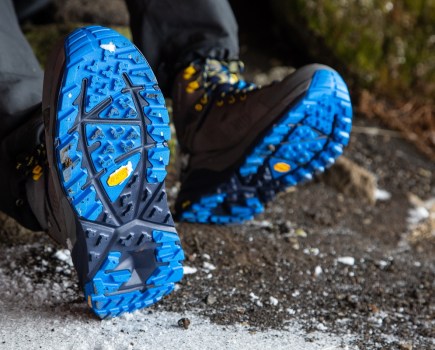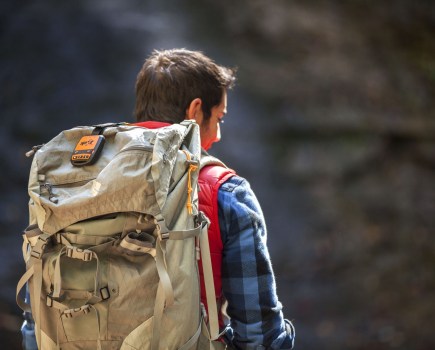How do sleeping bags work and keep you warm at night? We explain the science clearly and simply, so that you can get the maximum warmth from your sleep system when camping or bivvying.
A cold night camping can ruin any outdoor adventure. But understanding a little bit about how sleeping bags work can help you to stay warm so that you can enjoy a decent night’s sleep, wherever you pitch up. Part of it is about having the right kit for cold conditions – after all, there’s no substitute for good gear, though it doesn’t have to be expensive as proven in our guide to the best sleeping bags. But we’ve also included a number of tips and tricks to help you stay cosy on camp.
Words: Matthew Jones | Main image: Dougie Cunningham
How the body loses heat
How do sleeping bags work? You first need to know a bit about why we get cold. The human body loses heat in five different ways.
- Evaporation: water cooling the skin, either through sweating or if wearing wet clothing.
- Conduction: when heat moves from a warmer surface to a cooler one (which is why you feel cold when lying or sleeping directly on the ground).
- Convection: airflow moving across the skin – in outdoor terms, this is often simplified as ‘wind chill’.
- Respiration: breathing out warm air from inside the body (which is why your breath condenses in cold air).
- Radiation: the process of heat moving away from the body in cold air temperatures.
Convection explained
Heat loss through convection increases in cold, windy weather conditions, while wearing wet clothing greatly increases heat loss through conduction and evaporation. There’s not much you can do about respiration, since we all need to breathe (though inhaling through the nose can help). But in normal conditions, the body loses roughly 65% of its heat through radiation, making this by far the biggest factor.
This is especially true when camping since sleeping bodies are static and usually sheltered, e.g. in a tent, under a tarp or in a bivvy bag. All these forms of shelter mean you’re not generally exposed to wind chill, and hopefully you won’t be sweating or wearing wet clothing either. When you’re at rest, you’re not breathing particularly hard or fast either, and provided you have a decent sleeping mat (more on this later), heat loss from conduction is also reduced.
But since the outside air will almost always be cooler than the temperature of the surface of your skin (usually between 92.3 and 98.4°F or 33 to 37°C), heat loss via radiation is a big issue. The solution is to warm the air nearest to your skin. And that’s where sleeping bags come in.
10 ways to stay warm while camping
Now that you understand how a sleeping bag works, we want to now make sure that you get the most efficient performance back from your sleeping bag, To do this, there are a number of tips and tricks you can use to help you get a warmer night’s sleep.

Credit: Nordisk
-
Make sure your sleeping bag fits
If you’re buying walking boots or a hillwalking jacket, you’d want them to fit properly. Unfortunately, fewer people seem to think about fit when buying a sleeping bag – but it is just as important for warmth.
For a sleeping bag to work, it should of course be long and wide enough to fit you comfortably. However, you should aim to minimise ‘dead space’ inside the bag. Smaller spaces warm up faster and retain heat more efficiently. That’s why most performance sleeping bags use a closely contoured, tapered mummy shape. Cinch in the hood and zip the bag up fully for maximum warmth.
Of course, some find these bags restrictive and prefer a roomier cut, like a ‘relaxed mummy’ shape or even a rectangular bag. That’s fine – it’s about balancing comfort and warmth. There’s no point being nice and cosy in your bag but also feeling like you’re trussed up in a straitjacket. Just remember that bigger sleeping bags may not feel quite as cosy as a closer-fitting bag, because the more space or air there is inside the bag, the longer it will take to warm up.
-
Make sure your bag is clean and dry
You want all the insulation inside your sleeping bag to be as plump and fluffy as possible in order to trap the maximum volume of air. If the fill is damp or contaminated with sweat, dirt or body oils, it won’t loft properly. This is why it’s so important to keep your sleeping bag clean and dry.
Sleeping bags work best when using a sleeping bag liner, which prevents the bag itself from coming into contact with your dirty, sweaty body. Using a waterproof stuff sack and/or a pack liner will also ensure that your bag doesn’t absorb moisture and get damp in your rucksack.
-
Give your bag time to loft
Your sleeping bag will take some time to loft fully if it has been compressed in a stuff sack. So, it’s a good idea to set up your sleep system at least 15 minutes before you go to bed. Get in the habit of inflating your sleeping mat and unpacking your sleeping bag as soon as you’ve pitched your tent. This gives the bag plenty of time to loft before you climb inside it.
Long-term compression of both down and synthetic fills can also impair their ability to loft. So, while it’s fine to store your bag in its stuff sack while you’re camping or backpacking, when you get back home, keep it in a larger mesh or cloth storage sack. Most quality sleeping bags come with a storage sack in addition to a compression stuff sack to enable you to do this.
-
Don’t stick your face inside your bag
Since the body loses some heat through respiration (breathing in and out), it might seem like a good idea to bury your face inside your sleeping bag at night. This is not generally advisable though. The moisture in your breath tends to condense inside your bag, causing it to feel cold, damp and clammy. By all means, cinch in the hood of your bag, but try to keep your mouth and nose uncovered.
-
Go to bed warm
Remember that a sleeping bag does not actively generate warmth – it’s an insulator, not a heater. It simply traps the heat produced by your own body. As such, it’s worth going to bed warm by doing some light exercises before you climb into your sleeping bag. You don’t want to work hard enough to sweat, just enough to raise your heart rate so that you start to feel warm. Jumping up and down or doing a few jumping jacks or sit-ups generally does the trick.
Having a hot meal or a hot drink before bed can also help, by warming the body and stimulating your metabolism. That’s one reason why it’s a good idea to take a small backpacking stove with you to camp.
-
Use a hot water bottle
Rather than relying on your own body heat alone to generate warmth, you can use a hot water bottle to speed up the process. If you’re camping on a campsite, you can use a standard hot water bottle just like the ones people take to bed at home.
If you’re backpacking or wild camping, many campers boil water on a stove and pour it into a metal SIGG-style water bottle or canteen, before wrapping it in a thick walking sock and then placing it inside their sleeping bag. This can be very effective – often, the bottle is still warm in the morning.
-
Wear warm layers
For maximum warmth, wear a layer of dry thermal base layers at night. This should include a long-sleeved top and a pair of tights – merino wool is an excellent choice. In addition, you should wear a hat and a pair of warm socks to bed. This minimises body heat lost through the head, neck, wrists and ankles, where blood vessels are closer to the surface of the skin.
There’s a persistent myth in the outdoor world that it is warmer to sleep naked in your sleeping bag. The theory is that this maximises the effect of radiation so that your body warms the air in your bag more quickly. This is not true. Firstly, more exposed skin means you’re more likely to lose heat from convection and conduction. Secondly, layers of clothing act in much the same way as your bag itself, by trapping warm air against your skin. Wearing clothes simply adds an extra insulating barrier – in the same way that triple-glazed windows are more effective than double-glazing.
It’s also worth remembering that when sleeping bags are tested for warmth using the EN or ISO standards, the test method uses a heated mannequin fitted with 15 temperature sensors to represent a sleeping person. But the mannequin is also dressed in a base layer top, tights, long socks and hat, before being placed inside the sleeping bag. So, sleeping bag temperature ratings are calculated with clothed users in mind. If there was a better way to boost the performance of their sleeping bags (like testing with a naked mannequin), manufacturers would have adopted it.
-
Buy a good sleeping mat
As we’ve learned, one way the body loses heat is through conduction – when heat moves from a warmer surface to a cooler one. This is why it is so important to pair your sleeping bag with a good sleeping mat or pad. While a bag insulates your body from the cold external air, a mat insulates your body from the cold ground beneath you. They work in much the same way, by trapping warm air.
The three main types of sleeping mat are closed-cell foam mats (like a classic roll mat or Z-fold mat), self-inflating mats and air mats. Their insulating value is given by an R-value, which is a measurement of thermal resistance. In other words, the R-value tells you how well your sleeping mat resists heat loss. The higher the R value, the better it insulates you from the cold ground. As a rule of thumb, an R value of 1.0 to 2.0 is suitable for mild summer conditions, but you’d need a rating of at least 4.0+ for cold-weather camping.

Picture credit: James Roddie
-
Prevent draughts in your tent
We also know that heat loss occurs via convection or airflow. Static air gradually warms up, whereas continuously circulating air is cooler, and also cools surfaces that it comes into contact with (like your skin). So, eliminating draughts from your tent can be one way to boost warmth. However, you need to be careful here. That’s because a lack of airflow inside a tent can also lead to condensation build-up. This is bad since moisture both impairs the insulating performance of sleeping bags and speeds up bodily heat loss. Ideally, try to ensure there is some airflow through your tent at night to help manage moisture, but not enough for it to feel draughty.
-
Share body warmth
Most of the time sleeping bags work well but, If all else fails, sharing body warmth with another person is one of the best ways to keep warm. It’s a classic trick from pretty much every outdoor survival manual ever written. This is one advantage of sharing a tent with a buddy or partner rather than going solo (and a consideration when backpacking, since sleeping in a two-person tent is usually warmer than taking two solo tents).
More info on how sleeping bags work and buying advice
We hope you enjoyed our article on how sleeping bags work. For more technical advice on sleeping bags, we’ve produced a range of useful articles. They’re also essential reading if you’re considering buying a new sleeping bag, as are our buyer’s guides, product round-ups and detailed product reviews.
- How do sleeping bag ratings and temperatures work?
- Are sleeping bags waterproof?
- What types of sleeping bag are there?
- How to choose a three-season sleeping bag
- The best three-season sleeping bags
For more articles by Matthew Jones, check his bio page out here: Matthew Jones – Writer








